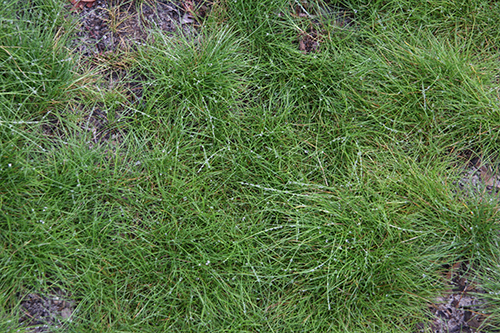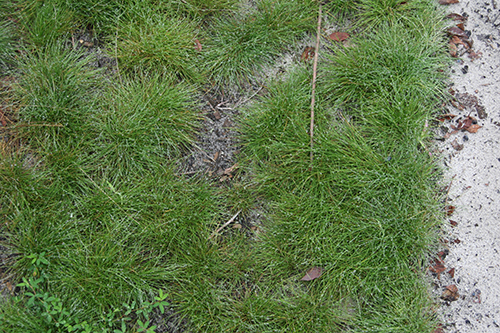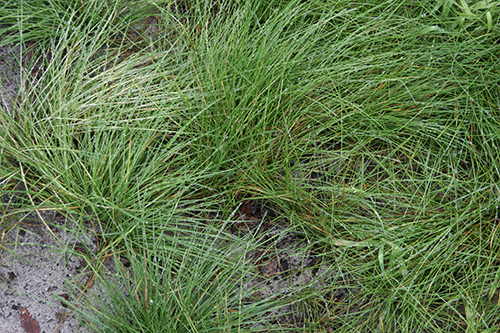Fact Sheet FS1357
Clean cultivation is a standard management practice among New Jersey producers of highbush blueberry. This practice requires both tillage and herbicide applications to maintain a weed-free environment between rows of blueberry (Figure 1). Growers are now seeking alternatives to clean cultivation because of the well-known consequences for soil health and the corresponding impacts on overall plant health.
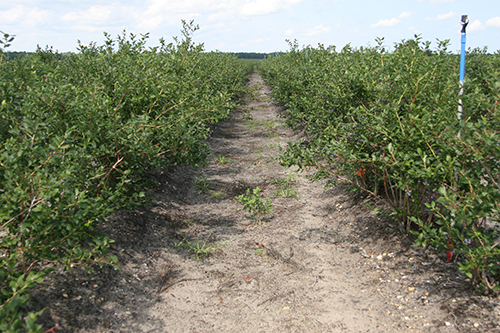
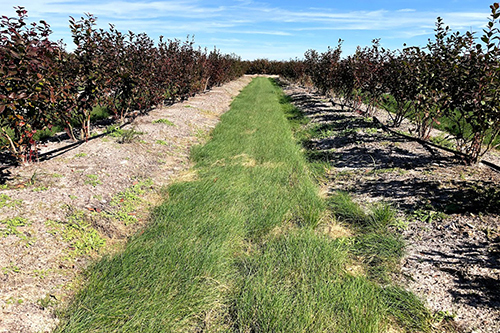
One practical alternative to clean cultivation is the use of fescue grasses as permanent cover crops between the rows of blueberry (Figure 2). The goals of permanent cover crops are to minimize soil erosion, improve soil organic matter, and enhance weed management. Growers also report that fescue-planted fields are more readily accessible following rain events, and the groundcover creates a cleaner, more comfortable environment for workers during hand-harvesting and pruning operations. There are, however, concerns that this practice may lead to increased incidence of root-feeding white grubs and increased vulnerability to frost damage.
Types of Fescue Grasses
Fine fescues and tall fescue are cool-season, perennial grasses that have been evaluated locally and are widely recommended in the region. Each type has unique attributes that make them well suited for the challenging soil conditions typical of blueberry farms in New Jersey (e.g., low soil pH, low soil organic matter, high percentage of sand). Fine fescues are generally slower growing and have finer leaf blades than tall fescue.
Fine Fescues
Fine fescues are several grass species valued for their tolerance of sandy, acidic soils prone to drought conditions. They perform best in well-drained soils and are tolerant of shaded environments typical of row middles found in an established blueberry field. Fine fescues require little maintenance and are good competitors with weeds during times of drought or fertility stress. Summer dormancy of these grasses allows them to survive hot summers without irrigation.
Hard Fescue and Sheep Fescue
Hard fescue (Figure 3a) and sheep fescue (Figure 3b) are types of fine fescue that are very similar in appearance. Both are bunch-type grasses that spread by tillering and form a dense ground cover at maturity. They have a relatively slow rate of establishment. Under low maintenance, hard fescue has the best performance of the fine fescues. Sheep fescue has a less aggressive growth habit but still performs well in the soil conditions typically found in blueberry culture. It has been noted that monoculture stands of these clump-type fescues create a bumpy condition for tractor operations in the row middles. If this is problematic, then a mixture of clumping and spreading species may be used to improve soil coverage and create a smoother surface.
Red Fescues
Red fescue species include creeping (Figure 3c) and bunch types. Slender creeping red fescue and strong creeping red fescue both spread through underground rhizomes and tolerate some close mowing. These species are similar but, as the name suggests, strong creeping red fescue has more rhizome growth and a greater spreading ability. Chewings fescue is a bunch-type red fescue that lacks rhizomes and is recognized for good tolerance of drought and soil acidity, even in low fertility environments. Although Chewings fescue has not been evaluated for application in NJ blueberry soils, it may be beneficial in a seed mixture due to these characteristics. Overall, red fescues tolerate lower mowing than hard and sheep fescues and tend to have the greatest seedling vigor and shade tolerance of the fine fescues.
Tall Fescue
Tall fescue (Figure 3d) exhibits exceptional heat tolerance and a deep root system and is excellent for erosion control, a valuable trait in degraded blueberry soils. Like the hard and sheep fescues, tall fescue exhibits a bunch-type growth habit, adaptation to a wide range of soils, and moderate shade tolerance. In addition, tall fescue is more tolerant of traffic than the fine fescues. Tall fescue performs best on well-drained soils with moderate fertility and a soil pH of 6.5 but can tolerate a pH as low as 5.0.
Establishment
Soil testing is key to successful establishment of fescues. Soil samples should be collected one year in advance of seeding to ensure soil pH is raised above 5.0 through limestone application. The need for phosphorus and potassium fertilizer will be determined by your soil test results. If P and K are required, broadcast and incorporate them prior to seeding. At planting, nitrogen should be broadcast at a rate of 20–40 pounds per acre to aid establishment.
Late summer to early fall is the ideal planting window for all fescues to allow sufficient time for establishment before the onset of winter. Spring seeding should be avoided because competition from warm-season weeds can impede establishment.
In southern New Jersey, fescues should be seeded between August 20 and October 10 while, in northern New Jersey, seeding between August 15 and October 5 is ideal. Earlier dates in these ranges are preferred when soil moisture is sufficient to support rapid germination.
Prepare a fine, weed-free seedbed by tilling the inter-row space. Rake the soil to remove any debris such as rocks or clumps of weeds. Grass seed should not be planted deeper than ¼ inch. Fescues seeded using either a John Deere Frontier TR1048 Grass Overseeder or a Truax TR48G have been successfully established in the past. It is possible to use a broadcast spreader or similar implement, but this is not ideal. If seed is broadcast, improve seed-to-soil contact by rolling the seedbed with a cultipacker or similar implement after planting to incorporate the seed into the soil surface ¼-inch. Grass establishment will be aided by overhead irrigation or rainfall soon after planting.
The recommended seeding rate for tall fescue is 75 pounds per planted acre. The recommended seeding rate for fine fescues is 70–80 pounds per planted acre.
Maintenance
Weed Management and Fertility
Key components of a successful weed management program are to reduce the spread of weeds by preventing seed production and introduction of new seeds. Blooming broadleaf weeds such as clover or dandelion are very attractive for pollinators and may attract pollinators when insecticides must be sprayed.
In nonbearing blueberry, Gallery 75DF (0.75 lb. a.i./A) can be applied in early spring on sod established for at least 6 months to prevent the emergence of annual summer broadleaf species. In bearing blueberries, Callisto 4L (0.094 lb. a.i./A) can be applied pre-emergence in early spring or post-emergence later in the season for controlling broadleaf weeds.
Pre-emergence application will require rainfall or overhead irrigation to move the herbicide into the soil before weeds emerge. However, rainfall within several hours following a post-emergence application will reduce the effectiveness of weed control. For post-emergence applications, weeds should be in an active state of growth and not drought stressed at the time of application.
Mowing, as required, will help limit the establishment of broadleaf weeds. Mowing is usually effective on broadleaf weeds that have a growing point located high on the plant and that can be easily cut off. Mowing closer than 4 inches from the soil can favor the development of clover, if it is already present, and reduce summer heat tolerance of the grass over time. Plan to mow 1–2 times prior to blueberry fruit set and again following blueberry harvest. Mowing between fruit set and harvest is not possible as blueberry canes weighed down by the fruit load spread into the row middle.
Clover spread can also be stimulated with phosphorus and potassium fertilizer whereas nitrogen will stimulate the growth of grasses. Therefore, reduce potassium and phosphorus fertilization if clover is a problem. Sandy, low-fertility sites may benefit from annual fall applications of 25 pounds per acre of nitrogen. Care must be taken with fall fertilizer applications since application to blueberry bushes can delay onset of dormancy.
A hillside cultivator used to control weeds on the blueberry mounds is also effective at 'edging' the sod to keep it from spreading onto the mounds.
Root-feeding White Grub Management
The use of fescues as permanent cover crops between row middles in blueberry fields could increase the incidence of white grubs. Two species of particular concern are oriental beetle (Anomala orientalis) and Japanese beetle (Popillia japonica). Although the grubs (larvae) of these species feed on the roots of blueberries, grasses, and various weeds, Japanese beetle grubs prefer the roots of grasses and can thus become a problem when fescues are planted in the row middles. Japanese beetle adults could then feed on the foliage and fruits of nearby blueberries and contaminate fruit at harvest. Oriental beetle and Japanese beetle have a single generation per year. In the summer (June–August), adults emerge from the soil, mate, and deposit their eggs in the soil. Grubs feed on roots until October and, as soil temperatures cool, they move deeper into the soil to overwinter; the following April/May, they return close to the surface and begin feeding again before pupating and then emerging as adults.
Grubs can be monitored by taking soil samples around blueberry plants and in the fescue row middles. To accurately assess grub population, sample in a uniform pattern across the field by sampling at 10 to 20-foot intervals from at least 10 locations. Sampling should be done in August when grubs are easily seen and actively feeding. The most convenient method to take soil samples is the use of a standard golf course hole cutter (4.25" diam ~ 0.1 ft2). To find the grubs, shake the sample, search through the soil and roots, and then record the number of grubs found at each sampling site. Traps baited with the oriental beetle and Japanese beetle pheromones can be used to monitor for adults, although attraction of Japanese beetles to traps could increase damage in neighboring blueberry bushes.
Oriental beetle and Japanese beetle can be managed using behavioral, biological, and chemical control methods. Mating disruption can be used to control the oriental beetle. This behavioral method uses the sex pheromone to disrupt mating and is thus specific to oriental beetle. Certain entomopathogenic nematodes (EPNs) have shown some promise for controlling grubs in blueberry fields; particularly, the EPN Steinernema scarabaei can be used against oriental beetle larvae. EPNs are very sensitive to drying and should be watered in as soon as they are applied. Imidacloprid is the preferred material for controlling the grub stage in blueberry fields; however, it is most effective against young instars. Please follow recommendations in Besançon et al. (2022) on the use of imidacloprid.
Final Thoughts
In this factsheet, only a limited number of fescues are considered. However, other commonly recommended species such as perennial ryegrass may also be useful but require additional evaluation. Perennial ryegrass is a bunch-type, cool-season grass that exhibits rapid germination and establishment. Mixtures containing perennial ryegrass may provide improved soil coverage and this species could help prevent bumpy conditions in the row middles when included in a mixture. There are numerous, commercially available seed mixes that contain combinations of hard fescue, sheep fescue, Chewings fescue, creeping red fescues, and perennial ryegrass but these mixtures lack local data and the best ratios for mixing these species for integration into our blueberry production system remain unknown. The utility of native grass species as permanent cover between blueberry rows is also currently unknown.
References
Mention or display of a trademark, proprietary product, or firm in text or figures does not constitute an endorsement by Rutgers Cooperative Extension and does not imply approval to the exclusion of other suitable products or firms.
March 2024
Copyright © 2025 Rutgers, The State University of New Jersey. All rights reserved.
For more information: njaes.rutgers.edu.
Cooperating Agencies: Rutgers, The State University of New Jersey, U.S. Department of Agriculture, and Boards of County Commissioners. Rutgers Cooperative Extension, a unit of the Rutgers New Jersey Agricultural Experiment Station, is an equal opportunity program provider and employer.


